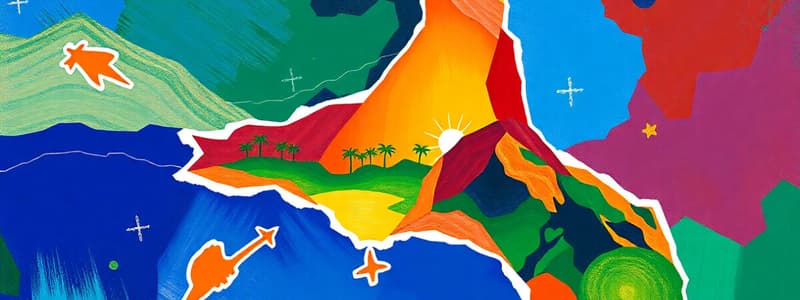Podcast
Questions and Answers
Which provinces border Kalinga?
Which provinces border Kalinga?
- Cagayan
- Apayao
- Isabela
- All of the above (correct)
What is the total area of Kalinga?
What is the total area of Kalinga?
3,231.25 square kilometers
Lubuagan was once the provincial capital of Kalinga.
Lubuagan was once the provincial capital of Kalinga.
True (A)
The municipality of Pasil is known for its large volumes of ______ deposits.
The municipality of Pasil is known for its large volumes of ______ deposits.
What type of farming progressed among the original mountain peoples?
What type of farming progressed among the original mountain peoples?
Match the municipalities of Kalinga with their features:
Match the municipalities of Kalinga with their features:
Kalinga has extensive areas of tropical rainforest in its lowlands.
Kalinga has extensive areas of tropical rainforest in its lowlands.
Study Notes
Kalinga Heritage: Settlements
- Kalinga is a landlocked province located in northern Luzon, Cordillera Region.
- It is bordered by the provinces of Cagayan and Apayao in the north, Mt. Province in the south, Abra in the west, and Isabela in the east.
- The province is characterized by mountains, steep slopes, valleys, and flatlands.
- Kalinga is known for its waterfalls, hot springs, rice terraces, and subterranean rivers, making it a potential tourist destination.
Kalinga Geography
- Kalinga has 3,231.25 square kilometers in area.
- Its lowlands are suitable for pasture while the highlands are dominated by tropical rainforests.
- Major rice producers include Rizal and Tabuk, followed by the mountainous areas and rice terraces of Balbalan, Lubuagan, Pasil, Pinukpuk, Tinglayan, and Tanudan.
Kalinga Municipalities
- Balbalan: Located in the northwest, founded in 1963.
- It is a fifth-class municipality with 14 barangays.
- 99% of its population is Kalinga native.
- Lubuagan: Formerly the provincial capital of Kalinga.
- Became a sixth-class municipality in 1963.
- Its population consists of 90% Kalinga natives, 10% Ilocanos and Tagalogs.
- Pasil: Created in 1966, south of Balbalan.
- Contains large sulfur deposits, hot springs, and an extinct volcano.
- Pinukpuk: Established as a municipal district in 1908 and as a sixth-class municipality in 1963.
- It has abundant narra trees, rattan, and other forest products.
- Rizal: Created in 1965.
- Its population is a mix of Kalingas, Bontocs, Benguets, Ibanags, Ilocanos, and Tagalogs.
- Tabuk: Capital of Kalinga.
- Its population comprises Kalingas, Bontocs Benguets, Ilokanos, Tagalogs, Ibanags, and other immigrants.
Studying That Suits You
Use AI to generate personalized quizzes and flashcards to suit your learning preferences.
Related Documents
Description
Explore the rich heritage and geographical features of Kalinga province in the Cordillera Region. This quiz covers its settlements, natural resources, and major municipalities, showcasing its potential as a tourist destination. Test your knowledge of Kalinga's landscapes, agriculture, and local culture.




